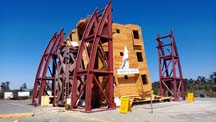July 9, 2014
Conference talks focus on quake-vulnerable wood-frame buildings
 |
|
Researchers conducted tests of a wood-frame building using an outdoor shake table at the University of California, San Diego. The work was part of the NEES-Soft project to better understand the collapse behavior and to improve the seismic safety of low-rise, wood-frame buildings - those no taller than four stories - which may have a "soft story" condition making them vulnerable to collapse even during a moderate earthquake. (Photo courtesy of Structural Engineers of Cal Poly Pomona). |
FORT COLLINS, Colo. – Earthquake engineering researchers are meeting this month with policy experts to discuss efforts to improve the seismic safety of low-rise, wood-frame buildings - those no taller than four stories - which may have a "soft story" condition making them vulnerable to collapse even during a moderate earthquake.
In soft-story construction, the first floor of a building lacks lateral strength because of large openings used for garages. For this reason, the buildings are particularly vulnerable to earthquake damage, said John W. van de Lindt, the George T. Abell Distinguished Professor in Infrastructure in the Department of Civil and Environmental Engineering at Colorado State University.
"The existence of thousands of soft-story wood-frame buildings in California has been recognized as a disaster preparedness problem with concerted mitigation efforts under way in many cities throughout the state," said van de Lindt, who has led an effort to improve the buildings called Seismic Risk Reduction for Soft-Story Woodframe Buildings, a collaboration of researchers from five universities and industry funded by the National Science Foundation's George E. Brown Jr. Network for Earthquake Engineering Simulation (NEES) program.
A building's soft story often functions as an open garage or commercial space.
"The open space and its lack of lateral stiffness and strength render such structures prone to collapse," he said.
New research findings will be detailed in talks during Quake Summit 2014, which is part of the 10th U.S. National Conference on Earthquake Engineering on July 21-25 in Anchorage, Alaska. The talks are included in a NEES special session on seismic retrofits of soft-story, wood-frame buildings. Researchers will give five talks on the testing, analysis and policy issues related to these structures.
The talks will be followed by a panel discussion moderated by van de Lindt and featuring civil engineering and policy experts from Los Angeles and San Francisco. The three-year project, referred to as NEES-Soft, was led by van de Lindt; Michael D. Symans, an associate professor in the Department of Civil and Environmental Engineering at Rensselaer Polytechnic Institute; Mikhail Gershfeld, Professional Practice Professor in the Department of Civil Engineering at California State Polytechnic University, Pomona; Weichiang Pang, an assistant professor in the Glenn Department of Civil Engineering at Clemson University; Xiaoyun Shao, an associate professor in the Civil and Construction Engineering Department at Western Michigan University; Colorado State graduate students Pouria Bahmani and Elaina Jennings; RPI graduate student Jingjing Tian; and Clemson graduate student Ershad Ziaei.
NEES-Soft aims to provide methods for retrofitting soft-story, wood-frame buildings to prevent collapse. Researchers are using "performance-based seismic design" to better understand collapse mechanisms and to validate the effectiveness of retrofits. The researchers used advanced modeling and a type of simulation called hybrid testing to accurately predict performance over a wide range of seismic loading conditions.
The performance-based design approach makes it possible to design buildings for specific geographical regions where earthquakes are prevalent, based on the needs of the building stakeholders or community.
The simulations are referred to as hybrid because they combine computational models with data from physical tests, including those using shake tables. Researchers also used real-time hybrid simulation, which allows testing at the actual speed of an earthquake, to shed light on the performance of retrofits.
Findings will include research results from two full-scale building tests: A three-story building was tested using a University at Buffalo NEES facility, and a four-story, 4,000-square-foot building was tested using a shake table at the University of California, San Diego.
The NEES special session, Seismic Retrofit of Soft-Story Woodframe Buildings: Testing, Analysis and Policy, focuses on lessons learned from the NEES-Soft project.
The presentations will include information about the use of "stiffness-based retrofits" for wood-frame buildings compared to the collapse test of a building lacking the retrofits; carefully designed damping systems that reduce seismic effects on structures; structural components and systems that improve the resilience of buildings; real-time hybrid simulation to study the performance of a damper system using a newly constructed Structural Engineering Laboratory at the University of Alabama; and development of a three-dimensional model to study the hybrid simulation of retrofits.
Writer: Emil Venere, 765-494-3470, venere@purdue.edu
Source: John W. van de Lindt, 970-491-6697, jwv@engr.colostate.edu
Note to Journalists: Electronic copies of the research papers are available by contacting Emil Venere, 765-494-4709, venere@purdue.edu
